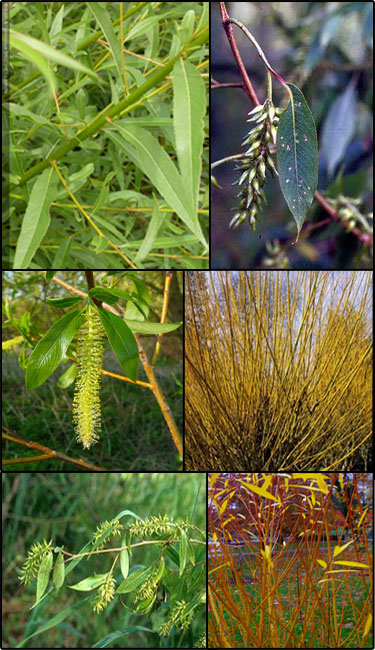Hybrid crack willow (Salix xrubens)
 Description: Hybrid cross between White willow (Salix alba) and Crack willow (Salix fragilis).
Description: Hybrid cross between White willow (Salix alba) and Crack willow (Salix fragilis).Habit: Tall, fully hardy, perennial, deciduous tree; 15 m (49.2 ft) tall, spread of 8 m (26.2 ft); 26-30 years to reach ultimate height.
Leaves: Green in Spring and Summer and green and yellow in Fall; lanceolate, long, narrow and toothed, small bumps (glands) on each side of the midvein, tiny stipules at the base of the petiole (leaf stalk) fall off soon after forming.
Stems: Greenish-yellow or yellowish, with alternate buds.
Flowers: Elongate clusters called catkins or aments, female flowers are 3.5-6.0 mm (0.14-0.24 in) long, glabrous, each on an evident stalk to about 0.7 mm (0.03 in) long; male flowers have 2 stamens.
Fruit and seeds: Tiny, covered with fine, cottony hairs; dispersed by wind and water.
Habitat: Native to Eurasia. Found in low fallow fields, along streams and in areas of abandoned habitation.
Reproduction: By seed.
Similar species: White willow (Salix alba); Crack willow (Salix fragilis); Wisconsin weeping willow (Salix xpendulina); Weeping willow (Salix xsepulcralis).
Monitoring and rapid response: Cut tree off at or just above ground level as level as possible then apply herbicides; effectively controlled using a water registered glyphosate product. Credits: The information provided in this factsheet was gathered from the USDA PLANTS Database and the Plant Database UK.
Individual species images that appear with a number in a black box are courtesy of the Bugwood.org network (http://www.invasive.org).Individual photo author credits may not be included due to the small display size of the images and subsequent difficulty of reading the provided text. All other images appear courtesy of Google (http://images.google.com).
Common Name: | Hybrid crack willow |
Scientific Name: | Salix xrubens |
Family: | Salicaceae (Willow) |
Duration: | Perennial |
Habit: | Trees |
USDA Symbol: | SARU3 |
